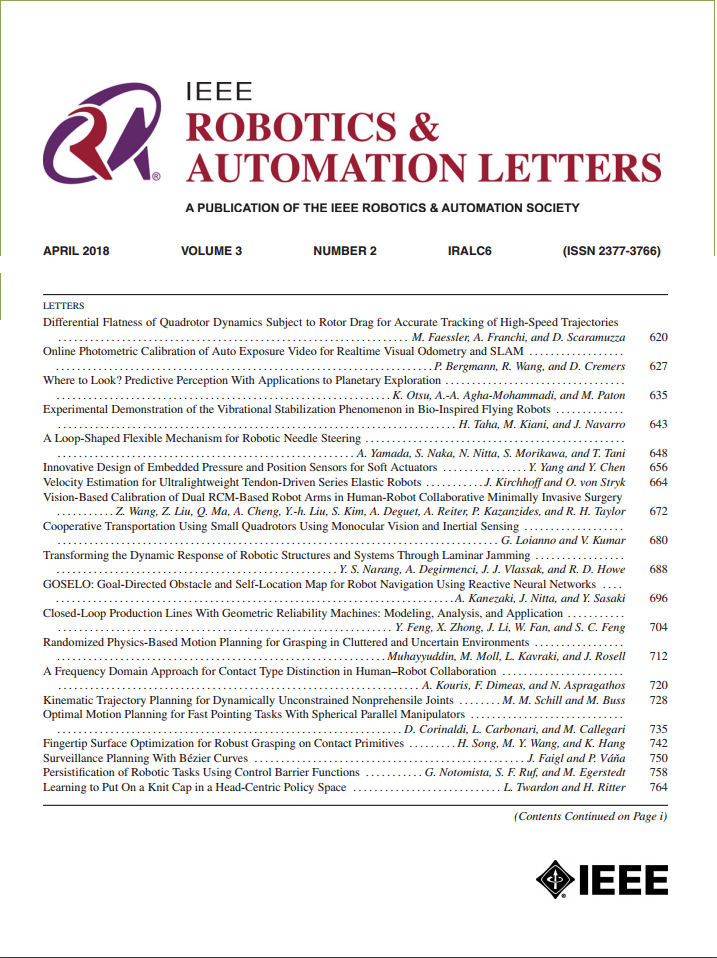ReLMBot:一种可重构的、有腿的、微型的模块化机器人,具有柔性或刚性的磁性连接机制
IF 5.3
2区 计算机科学
Q2 ROBOTICS
引用次数: 0
摘要
这封信介绍了ReLMBot,一个可重构的、有腿的、微型的、模块化的、带有磁性和被动机构的机器人。该机器人由多个模块组成,每个模块都配备了带有永磁体的主干,在不需要额外动力或驱动的情况下提供可重构性,同时提高了机器人的顺应性。此外,通过选择磁铁的不同几何形状,连接可以是刚性的(方形)或柔性的(圆柱形)。建立了包含机器人磁连接的动力学模型,仿真验证了机器人的攀爬性能和对接/解对接行为。结果表明,随着模块数量的增加,圆柱形磁体爬越障碍物的成功率和附加爬越高度明显高于方形磁体。此外,机器人相对于障碍物的起始位置对其攀登成功有重大影响。方形磁铁模块保持接近100%的成功率,直到刚好低于其攀爬极限,然后急剧下降,特别是较少的模块。圆柱形磁体逐渐下降,在失效前突然转动5mm。这些模块重29.43克,有手掌大小,允许它们对接和卸载以执行各种任务,包括攀登比单个模块更高的障碍物。这些模块拥有柔软的c型腿,可以在砾石、沙子或草地等不同地形上运行。该模块的微型结构、易于制造和可负担性使其成为多种用例的合适选择。机器人的无线通信能力使其成为一个强有力的竞争者,用于监视密闭空间,如倒塌的建筑物和核设施,大型区域,如农田,甚至是行星探测任务。本文章由计算机程序翻译,如有差异,请以英文原文为准。
ReLMBot: A Reconfigurable, Legged, Miniature, Modular Robot With Compliant or Rigid, Magnetic Connection Mechanisms
This letter presents ReLMBot, a reconfigurable, legged, miniature, modular robot with magnetic and passive mechanisms. The robot comprises multiple modules, each equipped with backbones featuring permanent magnets, which offer reconfigurability without requiring additional power or actuation while enhancing the robot’s compliance. Moreover, by choosing the geometry of the magnets differently, the connections can be made rigid (square-shaped) or compliant (cylindrical). A dynamic model incorporating the robot’s magnetic connections is developed to simulate and verify its climbing performance and docking/undocking behavior. The results demonstrated that cylindrical magnets achieve a higher success rate in climbing obstacles and provide significantly higher additional climbing height compared to square-shaped magnets as the number of modules increases. Furthermore, the robot’s starting position relative to the obstacle has a major impact on its climbing success. Modules with square-shaped magnets maintain near 100% success until just below their climbable limit, then drop sharply, especially with fewer modules. Cylindrical magnets show a gradual decline, turning abruptly 5 mm before failure. The modules weigh 29.43 grams and have palm-sized dimensions, allowing them to dock and undock to perform various tasks, including climbing obstacles higher than a single module. The modules possess soft c-shaped legs, enabling operation in diverse terrains like gravel, sand, or grass. The modules’ miniature structure, ease of manufacture, and affordability make them a suitable option for multiple use cases. The robot’s wireless communication capability makes it a strong contender for surveillance in confined spaces like collapsed buildings and nuclear sites, large areas like farmlands, and even planetary exploration missions.
求助全文
通过发布文献求助,成功后即可免费获取论文全文。
去求助
来源期刊

IEEE Robotics and Automation Letters
Computer Science-Computer Science Applications
CiteScore
9.60
自引率
15.40%
发文量
1428
期刊介绍:
The scope of this journal is to publish peer-reviewed articles that provide a timely and concise account of innovative research ideas and application results, reporting significant theoretical findings and application case studies in areas of robotics and automation.
 求助内容:
求助内容: 应助结果提醒方式:
应助结果提醒方式:


